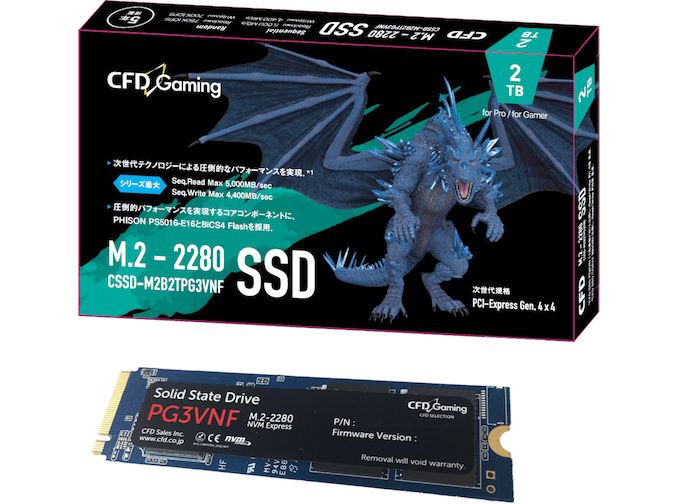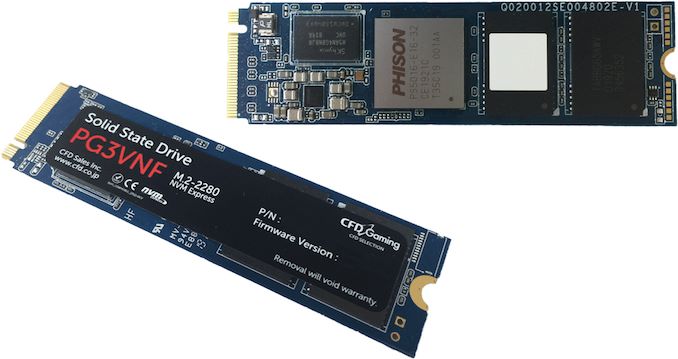Phison PS5016-E16 PCIe 4.0 SSDs: Random Read/Write Performance Disclosed
by Anton Shilov on July 2, 2019 10:00 AM EST
We spotted Phison PS5016-E16-based SSDs from over half of a dozen of companies at Computex several weeks ago and we are sure there are many more to come. While almost all suppliers demonstrated peak sequential read/write performance numbers of their upcoming drives, nobody showcased random read/write performance numbers. Last week Japan-based CFD company introduced its PS5016-E16-based drives and finally revealed all the information about their speed.
Because all Phison PS5016-E16-powered SSDs feature a PCIe 4.0 x4 interface, it is natural that they offer sequential read/write speeds of up to 5.0/4.4 GB/s which significantly exceed performance of contemporary high-end drives featuring a PCIe 3.0 x4 interface. Meanwhile, in real life random read/write performance affects user experience far more substantially than peak sequential read/write speeds and yet these numbers in case of PS5016-E16-based drives have never been disclosed until recently.
Fortunately, CFD published all the details about its PG3VNF SSDs, including random read and write performance numbers. As it appears, 1 TB and 2 TB versions of the drives offer up to 600K IOPS random read as well as up to 500K IOPS random write speeds. When compared to Phison PS5012-E12-based Corsair’s MP510, the new drives are not necessarily faster.
| Phison-Based SSD Comparison | |||||||
| Model | CFD PG3VNF 500 GB |
CFD PG3VNF 1 TB |
CFD PG3VNF 2 TB |
Corsair MP600 | Corsair MP510 | ||
| Form Factor | double-sided M.2 2280 |
double-sided M.2 2280 (with heatsink) |
double-sided M.2 2280 |
||||
| Interface | NVMe, PCIe 4.0 x4 | NVMe, PCIe 3.0 x4 | |||||
| Controller | Phison PS5016-E16 | Phison PS5012-E12 | |||||
| NAND Flash | Toshiba BiCS4 3D TLC | undisclosed 3D TLC | Toshiba 64-layer 3D TLC | ||||
| Capacities | 500 GB | 1 TB | 2 TB | ? | 240GB–1920GB | ||
| Sequential Read (max) | 5000 MB/s | 4950 MB/s | 3480 MB/s | ||||
| Sequential Write (max) | 2500 MB/s | 4400 MB/s | 4250 MB/s | 3000 MB/s | |||
| Random Read (max) | 400K IOPS | 600K IOPS | ? | 610K IOPS | |||
| Random Write (max) | 550K IOPS | 500K IOPS | ? | 570K IOPS | |||
| Warranty | 5 years | ||||||
| Write Endurance | ? | ? | ? | ? | 1.0 DWPD | ||
| TBW | 850 TBW | 1800 TBW | 3600 TBW | ? | ? | ||
| Release Date | July 2019 | October 2018 | |||||
Considering the fact that the Phison PS5016-E16 controller is essentially the PS5012-E12 controller with a PCIe 4.0 x4 interface, it is not surprising that the new drives hardly offer any improvement when it comes to random read and write speeds. On the other hand, since the SSDs offer substantially higher sequential read and write speeds, they will still provide advantages over existing drives.
SSDs powered by the Phison PS5016-E16 controller will be released later in July after AMD and its partners start to sell platforms that support the PCIe 4.0 technology.
Related Reading:











19 Comments
View All Comments
Metroid - Tuesday, July 2, 2019 - link
Random read and write is the most important thing for real life disk usage and yet it seems pcie4.0 drives at moment does not offer any benefit x pcie3.0 and yet they will cost a lot lot more.tipoo - Tuesday, July 2, 2019 - link
Once you clear a usable maximum random read/write I'm not sure I'd call it the "most important" thing for most people.cgeorgescu - Tuesday, July 2, 2019 - link
No, we are way behind any "usable" max random RW. While we're covered well by the sequential speeds that we have now (1-2GBps), we are left in the dark when it comes to random (where we barely get 50MBps). I'm talking low QD, stuff that matters.While 10 times faster sequential RW won't make any difference in real life, 10 times faster random RW would make a hell of a difference. Get me a drive that gets not 3 but 300GBps seq, my laptop won't be able to exploit it, but get me a drive that does 100 and not 50MBps 4k QD1 and all apps on my laptop will run way faster.
TheUnhandledException - Tuesday, July 2, 2019 - link
Meh. More random would be nice but not that long ago ultra expensive SAS enterprise drives were doing 200 IOPs. Even a storage server array with 48 drives might crack a a couple thousand IOPs. These SSD are doing 600K. Sure 6M would be even nicer but we have random performance that was simply unheard of at any cost in a $200 SSD these days.ksec - Tuesday, July 2, 2019 - link
We has always had this assumption where Super Fast Random RW is far more important, and yet all the test with Optane shown in Real Life Workload benchmark this isn't the case. Seq RW is still extremely important in nearly all cases, and especially the so called "lightweight" benchmarks on Anandtech.So no, your 10 times faster Random RW wont makes "hell" a lot of difference.
Jansen - Wednesday, July 3, 2019 - link
https://www.tomshardware.com/reviews/intel-optane-...TheUnhandledException - Tuesday, July 2, 2019 - link
Everything new costs more but long term PCIe 4 shouldn't be more expensive than PCIe 3. In fact in a lot of cases it could be cheaper. Entry level NVMe SSD could hit ~3.5 GB/s just using a cheaper 2 lane interface.damianrobertjones - Tuesday, July 2, 2019 - link
Companies will want to milk as many people from their $$$/£££ before truly offering something much faster.MrSpadge - Tuesday, July 2, 2019 - link
That's not the fault of the interface if thise performance is the limit of what the controller can do.Xajel - Thursday, July 4, 2019 - link
Seeing that they just replaced the PHY with PCIe 4.0 without any change to the actual controller, Then it's expected.They did that to accelerate the release of the PCIe 4.0 ssds, which will help with bandwidth. Native and actual PCIe 4.0 will surely have better optimization and utilization of PCIe 4.0 speed and features.